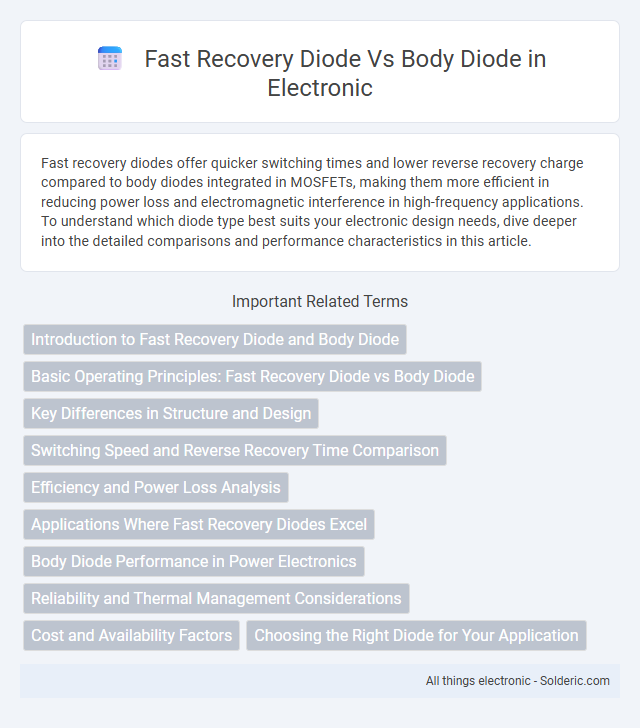Fast recovery diodes offer quicker switching times and lower reverse recovery charge compared to body diodes integrated in MOSFETs, making them more efficient in reducing power loss and electromagnetic interference in high-frequency applications. To understand which diode type best suits your electronic design needs, dive deeper into the detailed comparisons and performance characteristics in this article.
Comparison Table
| Feature | Fast Recovery Diode | Body Diode |
|---|---|---|
| Definition | Diode designed for quick switching and low reverse recovery time. | Intrinsic diode formed within MOSFET structure; conducts during switch off. |
| Recovery Time | Very fast, typically in nanoseconds. | Slower compared to fast recovery diodes; higher reverse recovery charge. |
| Usage | Used in high-speed switching applications to minimize losses. | Used inherently in MOSFETs, assists in freewheeling current path. |
| Power Loss | Low power loss due to fast recovery. | Higher power loss due to slower recovery and higher reverse recovery current. |
| Cost | Additional component, adds cost. | Integrated, no extra cost. |
| Applications | SMPS, inverters, motor drives where fast switching is critical. | Integrated in MOSFETs for general switching and energy recirculation. |
Introduction to Fast Recovery Diode and Body Diode
Fast recovery diodes are semiconductor devices designed to switch off rapidly, minimizing reverse recovery time and power loss in high-speed switching applications such as power supplies and inverters. The body diode, inherently formed within MOSFET structures, provides an intrinsic conduction path during reverse voltage conditions but typically exhibits slower recovery times and higher losses compared to dedicated fast recovery diodes. Understanding the distinct electrical characteristics and recovery behaviors of fast recovery diodes versus body diodes is critical for optimizing efficiency and reliability in power electronic circuits.
Basic Operating Principles: Fast Recovery Diode vs Body Diode
Fast recovery diodes utilize a controlled recombination process to minimize reverse recovery time, enabling faster switching and reduced power loss in high-frequency applications. Body diodes are intrinsic to MOSFET structures, formed by the PN junction between the MOSFET's drain and substrate, exhibiting slower recovery characteristics due to minority carrier storage. The fast recovery diode's optimized semiconductor doping and structure contrast with the body diode's inherent parasitic junction, impacting their efficiency and switching performance in power electronics.
Key Differences in Structure and Design
Fast recovery diodes feature optimized PN junctions and thinner layers that enable rapid recombination of charge carriers, minimizing reverse recovery time and switching losses. Body diodes are integrated within MOSFETs, inherently formed by the transistor's structure, resulting in slower recovery characteristics due to their unintended conduction paths and higher stored charge. The distinct semiconductor architecture in fast recovery diodes prioritizes efficiency in high-frequency applications, whereas body diodes provide intrinsic protection but with compromised switching performance.
Switching Speed and Reverse Recovery Time Comparison
Fast recovery diodes feature significantly higher switching speeds and shorter reverse recovery times compared to body diodes, making them more efficient for high-frequency applications. Your circuits benefit from reduced power loss and minimized electromagnetic interference due to the swift transition from conducting to blocking states. Body diodes typically exhibit slower switching speeds and longer reverse recovery times, which can cause greater switching losses and increased thermal stress in power devices.
Efficiency and Power Loss Analysis
Fast recovery diodes exhibit lower reverse recovery charge and faster switching times compared to body diodes, resulting in reduced switching losses and improved overall efficiency in power electronic circuits. Body diodes, often intrinsic to MOSFETs, typically have slower recovery characteristics and higher stored charge, which increases power dissipation during switching transitions. In high-frequency applications, selecting fast recovery diodes significantly minimizes power loss and enhances system performance by reducing conduction and switching losses.
Applications Where Fast Recovery Diodes Excel
Fast recovery diodes excel in high-frequency switching applications such as power supplies, inverters, and motor drives due to their low reverse recovery time and reduced switching losses. These diodes improve efficiency and thermal performance in circuits where switching speed is critical. Your power electronics designs benefit from enhanced reliability and lower electromagnetic interference when using fast recovery diodes over body diodes in these scenarios.
Body Diode Performance in Power Electronics
Body diodes in power electronics provide intrinsic reverse conduction paths within MOSFETs, offering quick switching capabilities but often suffer from higher reverse recovery charge and losses compared to fast recovery diodes. Fast recovery diodes are optimized for lower reverse recovery time and reduced switching losses, improving overall efficiency in high-frequency applications. Understanding the trade-offs in body diode performance helps you select the right component for minimizing power dissipation and thermal stress in your design.
Reliability and Thermal Management Considerations
Fast recovery diodes offer higher reliability in power electronics due to their lower reverse recovery time, reducing switching losses and stress on components compared to body diodes inherent in MOSFETs. Thermal management improves with fast recovery diodes as they generate less heat during switching, minimizing thermal hotspots and extending device lifespan. You can enhance system performance and durability by selecting diodes that optimize recovery characteristics and thermal efficiency.
Cost and Availability Factors
Fast recovery diodes generally have higher costs compared to body diodes due to their specialized doping profiles and advanced manufacturing processes, resulting in better performance in switching applications. Body diodes, integrated within power MOSFETs, come at lower additional cost and are widely available as part of standard transistor packages, making them more accessible for budget-sensitive designs. Availability of fast recovery diodes is slightly more limited to specific electronic component suppliers, whereas body diodes benefit from broad distribution through common semiconductor manufacturers and distributors.
Choosing the Right Diode for Your Application
Fast recovery diodes offer rapid switching times and low reverse recovery charge, making them ideal for high-frequency power electronics and switching applications. Body diodes, integrated within MOSFETs, provide inherent protection but exhibit slower recovery and higher losses, which can impact efficiency in fast-switching circuits. Selecting the right diode depends on your application's switching speed, efficiency requirements, and thermal management considerations.
Fast recovery diode vs Body diode Infographic

 solderic.com
solderic.com